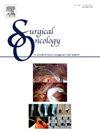Do unplanned resections in soft tissue sarcomas of the extremities have an adverse impact on the prognosis? Experience of a Latin-American sarcoma reference center
IF 2.4
4区 医学
Q3 ONCOLOGY
引用次数: 0
Abstract
Background
Soft tissue sarcomas (STS) are rare, heterogeneous neoplasms often not optimally managed by teams without sarcoma expertise. Between 40 % and 50 % of primary resections for extremity sarcomas occur without prior biopsy, resulting in inadequate excisions, termed “unplanned resections” or “whoops surgery.”
Objective
To determine the rate of unplanned resections in extremity STS referred to a high-volume sarcoma center and evaluate their impact on oncological outcomes.
Methods
A retrospective study of 680 extremity STS patients referred between 2005 and 2020. Of these, 239 (35 %) had unplanned resections. We analyzed the impact of unplanned resections on recurrence, disease-free survival (DFS), and overall survival (OS) after re-excision.
Results
Among the 239 patients with unplanned resections, 52 % were male, the median age was 46, and the most common histologies were liposarcoma (24 %) and synovial sarcoma (20 %). The median tumor size was 9 cm. Re-excisions achieved R0 margins of 88.6 %. Recurrence occurred in 26.3 % of cases and progression in 12.9 %, with an overall recurrence or progression rate of 39.2 %. The median DFS was 151 months for R0 resections, compared to 57.1–61.8 months for R1/R2 resections. The median OS was 140 months for R0 resections versus 50.8–52.3 months for R1/R2 resections.
Conclusions
Unplanned resections by non-specialized surgeons significantly reduce DFS and OS. Nonetheless, re-excision with negative margins (R0) provides oncological outcomes comparable to those reported in planned surgeries, emphasizing the importance of timely referral to specialized sarcoma centers.
肢体软组织肉瘤的非计划切除对预后有不良影响吗?拉丁美洲肉瘤参考中心的经验
背景:软组织肉瘤(STS)是一种罕见的异质性肿瘤,通常不能由缺乏肉瘤专业知识的团队进行最佳治疗。40% - 50%的肢体肉瘤原发切除没有事先活检,导致切除不充分,称为“计划外切除”或“哎呀手术”。目的确定高容量肉瘤中心的肢体STS非计划切除率,并评估其对肿瘤预后的影响。方法对2005 ~ 2020年间680例肢体STS患者进行回顾性分析。其中239例(35%)为计划外切除。我们分析了非计划切除对复发、无病生存(DFS)和再切除后总生存(OS)的影响。结果239例非计划切除患者中,男性占52%,中位年龄46岁,最常见的组织学为脂肪肉瘤(24%)和滑膜肉瘤(20%)。中位肿瘤大小为9cm。再切除率为88.6%。复发占26.3%,进展占12.9%,总体复发或进展率为39.2%。R0切除的中位DFS为151个月,而R1/R2切除的中位DFS为57.1-61.8个月。R0切除的中位OS为140个月,而R1/R2切除的中位OS为50.8-52.3个月。结论非专业外科医生的非计划切除可显著降低DFS和OS。尽管如此,阴性切缘(R0)的再切除提供了与计划手术报告的肿瘤预后相当的结果,强调了及时转诊到专门的肉瘤中心的重要性。
本文章由计算机程序翻译,如有差异,请以英文原文为准。
求助全文
约1分钟内获得全文
求助全文
来源期刊

Surgical Oncology-Oxford
医学-外科
CiteScore
4.50
自引率
0.00%
发文量
169
审稿时长
38 days
期刊介绍:
Surgical Oncology is a peer reviewed journal publishing review articles that contribute to the advancement of knowledge in surgical oncology and related fields of interest. Articles represent a spectrum of current technology in oncology research as well as those concerning clinical trials, surgical technique, methods of investigation and patient evaluation. Surgical Oncology publishes comprehensive Reviews that examine individual topics in considerable detail, in addition to editorials and commentaries which focus on selected papers. The journal also publishes special issues which explore topics of interest to surgical oncologists in great detail - outlining recent advancements and providing readers with the most up to date information.
 求助内容:
求助内容: 应助结果提醒方式:
应助结果提醒方式:


